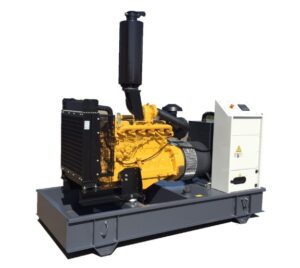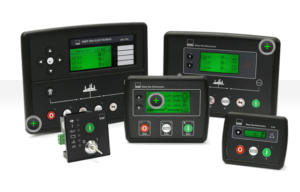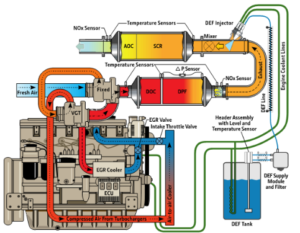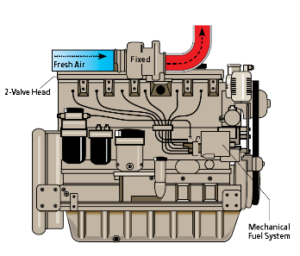A generator set is a machine made up of an internal combustion engine (usually a diesel engine or a gas engine) and an electrical generator or alternator. The objective of the generator set is to be able to generate an electrical current that supplies the demand of an installation or a building.
USES OF GENERATING SETS
In most cases the groups are used due to the absence of electrical network.
In these cases, the equipment can work sporadically when the user needs it or it can be turned on for 24 hours, due to the need to have electrical devices permanently plugged in.
However, there are many sectors in which the groups are used while living with the electrical network, either:
1.- Going into operation when the electrical network goes out:
EMERGENCY USE: In these cases, we can start the group manually when the power goes out or we can include a device that detects the absence of a network and starts the group automatically, doing the opposite when the power supply is restored. This device is known as a switchboard.
2.- Or working in parallel with the electrical network, providing part of the power that is needed in the installation.
In this case, the group signal (frequency, voltage, etc.) must be permanently synchronized with the one provided by the network; for this, we will need a synchronization box.
COMPONENTES ESENCIALES DE LOS GRUPOS ELECTROGÉNOS

THE MOTOR
THE ALTERNATOR
THE CONTROL PANEL
A generator set is made up of three main components:
THE MOTOR:
Generator set engines run at constant speed. It is the speed at which they get the frequency that is agreed in most countries. 1,500 rpm / 50 Hz, although in Latin America some countries work at 1,800 rpm / 60 Hz.
Apart from durability, warranty and maintenance intervals, a good motor must be fast responding to load impacts, because if the time in which it recovers its speed varies a lot, variations will be generated in the signal frequency and we could damage the electrical devices that we intend to power.

THE ALTERNATOR:
It is the device that generates electricity from the rotational movement of the motor. Today’s alternators are brushless and have AVR, Automatic Voltage Regulation. The quality of the electricity is very good, in such a way that it does not damage the electrical equipment that they have to feed.


THE CONTROLLER:
It is the device that gives us information about the main operating parameters of the generating set, allows us to see parameters such as voltage (V), current (A), engine speed and indicates possible operating alarms.

WHICH GENERATING SET IS SUITABLE FOR ME?
We have to know the minimum quality required of a generator set
depending on the purpose for which they are intended.
EXAMPLE OF THE MOPED AND THE MOTORCYCLE:
If we are going to buy a motorcycle just to go to work that is 5 minutes from home, a moped will be worth it. If, on the other hand, we want to go to town 200 km away every weekend with the motorcycle and also take our wife behind us, then we will have to buy at least a 600 cc YAMAHA, for example.
With this we do not mean that the moped is bad, we mean that each vehicle is designed and manufactured for different uses.
The same goes for groups:
The groups are cheaper if they are air-cooled and work at 3,000 rpm (which allows them to increase their power, in exchange for reducing their useful life), their alternator usually has brushes (worse electricity quality than with brushless alternators) and They do not have any device that allows them to start by external signal.

For isolated installations of a certain magnitude, we will need a group at 1,500 rpm, which can be started by an external signal, with a quality alternator that does not release the inverter due to frequency variations and, if possible, which is silent and low consumption.
In addition, we want it to be able to handle different situations, overloads, battery recharging, or even to function continuously due to possible failures in the rest of the system.

RANGES OF GENERATING SETS
LIGHT RANGE up to (6-20 kVA)
The LIGHT RANGE, with motors up to 20 Kva, are especially indicated for supporting photovoltaic installations.
INDUSTRIAL RANGE up to (30-500 kVA)
The INDUSTRIAL RANGE, with motors from 30 to 350 kVA. They are used for higher power applications, such as off-grid agricultural and livestock farms.
New HEAVY RANGE (500-1500 kVA)
The new HEAVY RANGE with motors up to 800 kVA of power. They have been used as support groups for large photovoltaic solar installations-
DIESEL GENERATING SETS
Diesel engine generator sets have long been a standard on the market. Its good reputation is the result of its great flexibility of application, both industrial and domestic, and its robustness and reliability.
Advantages
- These are portable equipment, and powered by a fuel that is easily accessible and cheaper than gasoline.
- They are robust and reliable equipment, capable of ensuring many hours of operation per year.
- Diesel is a fuel that gives high performance to the equipment that uses it, since it burns at a higher temperature than gasoline.
- Diesel is also very safe, since it is less flammable than other types of fuel.
Desventaja
- The main disadvantage of mobile generators, as in the case of any machine that incorporates a diesel engine, is that it causes high levels of polluting gas emissions. For this reason, current mobile diesel generators incorporate an additional anti-particle filtering system that ensures their compliance with current legislation.


Motor diesel año 2019 Motor diesel año 1996
Motor diesel año 1996
GAS GENERATING SETS
Gas engine generators have been gaining a lot of popularity due to their great reliability, economy and sustainability.
They are synonymous with clean and economic energy


Advantages
- They are more respectful with the environment since gas produces fewer emissions than other non-renewable fuels (such as coal, diesel or gasoline).
- Its power supply is economical since gas is the most affordable fuel, second only to coal (which is not an option due to its high level of emissions).
- They are equipment with high compatibility and application, since it is possible to install them in remote places using high-capacity tanks.
- They are very quiet generators.
- GAS is difficult to steal, while Diesel is easy to empty the tank.
Disadvantages
- Higher acquisition cost than Diesel

